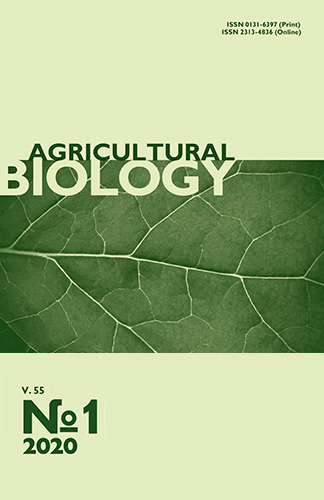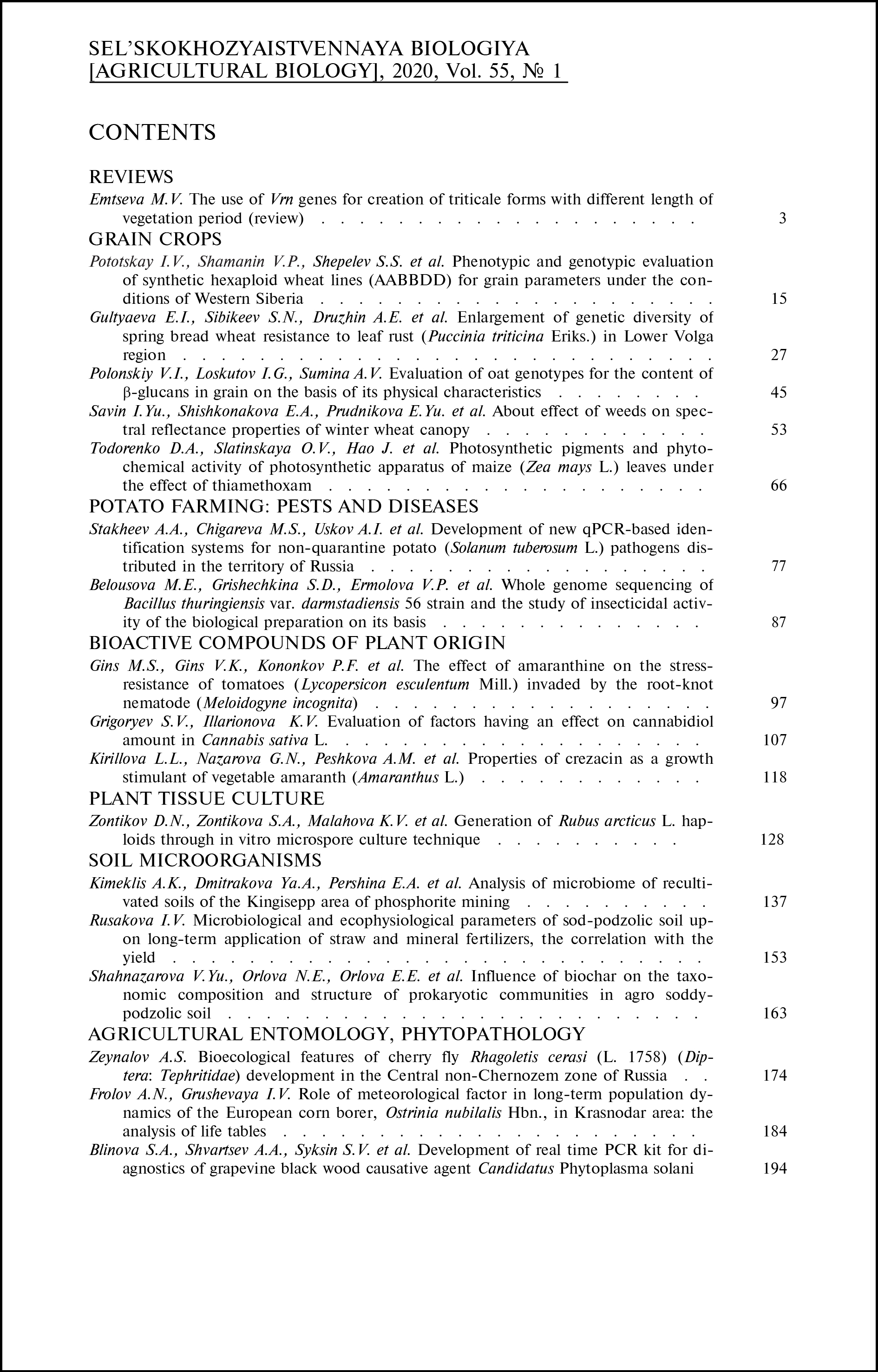doi: 10.15389/agrobiology.2020.1.184eng
UDC: 595.782:574.3:57.04(470.620)
ROLE OF METEOROLOGICAL FACTOR IN LONG-TERM
POPULATION DYNAMICS OF THE EUROPEAN CORN BORER,
Ostrinia nubilalis Hbn., IN KRASNODAR AREA: THE ANALYSIS
OF LIFE TABLES
A.N. Frolov, I.V. Grushevaya
All-Russian Research Institute of Plant Protection, 3, sh. Podbel’skogo, St. Petersburg, 196608 Russia, e-mail entomology@vizr.spb.ru (✉ corresponding author), grushevaya_12@mail.ru
ORCID:
Frolov A.N. orcid.org/0000-0002-6942-9951
Grushevaya I.V. orcid.org/0000-0003-4751-5442
Received March 27, 2019
The European corn borer, Ostrinia nubilalis Hbn. is one of the most dangerous pests of maize. Though weather, mostly air temperature and humidity, demonstrate their important influence on distribution, population level and development terms of the European corn borer, the accuracy of forecasting models remains rather low to predict pest population dynamics. The aim of our work consists in the comparison of meteorological data with the demographic indicators characterizing long-term population fluctuations in the European corn borer to identify the most significant meteorological criteria for the forecast of pest population dynamics. Observations of insect population dynamics conducted during 1994-2018 on maize fields in vicinity of village Botanika (Gulkevichi District, Krasnodar Area; 45°12'51'' N and 40°47'41'' E) during 1994-2018, and data obtained in 2018 were only used for verification of the dependence established on data array for 1994-2017. We estimated density of insect population at all stages of life cycle from egg to adult. The meteorological information was obtained from the Otrado-Kuban meteorological station located in the center of the territory of the test field location. Mortality for the different periods of insect development (eggs, I-II and III-V instar larvae, pupae, adults) was estimated as K = log N1 - log N2, where N1 and N2 are density of insects for the corresponding periods. Mortality for generation was calculates as K = log No - log Nf, where No and Nf is density of eggs and egg-laying females of the current generation. The breeding index per generation was calculated as I = Nt+1/Nt, where Nt and Nt+1 is density of eggs for the current (t) and the following (t + 1) generation, respectively. Two generations of the European corn borer annually develop in Krasnodar area, and size of population during the first generation usually grows, while those in second generation decreases. The demographic characteristics of insect statistically significant correlate with meteorological factors only during time interval from the third decade of May to the first decade of June when the peak of egg oviposition and mass hatching of I instar larvae of the first pest generation usually occur. Egg mortality shows the closest negative correlation with air temperatures and positive correlation with moisture (water drops and vapor). No association of demographic indicators with meteorological factors during oviposition and hatching of second-generation larvae was found probably due to formation of high and dense maize crops with a microclimate favorable for insect development. Thus, the data obtained demonstrate that the last decade of May — the first decade of June is the only critical period during the European corn borer development in the region. Based on the findings, we drown a 3D linear contour diagram of the European corn borer first generation egg mortality as dependent on mean daily air temperature and relative atmospheric humidity during the last decade of May. This dependence is of interest in terms of an improved model for short-term forecast of pest population dynamics in Krasnodar Area.
Keywords: European corn borer, population dynamics, demography, egg mortality, air temperature, air humidity, Krasnodar Area.
REFERENCES
- Frolov A.N. Izmenchivost' kukuruznogo motyl'ka i ustoichivost' k nemu kukuruzy. Avtoreferat doktorskoi dissertatsii [Variability and resistance of the corn moth. DSc Thesis]. St. Petersburg, 1993 (in Russ.).
- Bykovskaya A.V. Biologicheskoe obosnovanie i razrabotka meropriyatii po zashchite kukuruzy ot steblevogo kukuruznogo motyl'ka (Ostrinia nubilalis Hbn.) v Belarusi. Avtoreferat kandidatskoi dissertatsii [Biological basis and development of measures to protect corn from a stem corn moth (Ostrinia nubilalis Hbn.) in Belarus. PhD Thesis]. Priluki, 2015 (in Russ.).
- Kolesnikov L.O., Vasil'ev A.A. Vіsnik Poltavs'koї derzhavnoї agrarnoї akademії, 2017, 1-2: 34-37 (in Russ.).
- Szőke C., Zsubori Z., Pók I., Rácz F., Illés O., Szegedi I. Significance of the European corn borer (Ostrinia nubilalis Hübn.) in maize production. Acta Agronomica Hungarica, 2002, 50(4): 447-461 CrossRef
- Serapionov D.A., Frolov A.N. Vestnik zashchity rastenii, 2008, 2: 34-37 (in Russ.).
- Frolov A.N., Grushevaya I.V. Entomologicheskoe obozrenie, 2019, 98(1): 49-64 CrossRef (in Russ.).
- Frolov A.N., Ryabchinskaya T.A. Vestnik zashchity rastenii, 2018, 1(95): 5-11 CrossRef (in Russ.).
- O’Rourke M.E., Sappington T.W., Fleischer S.J. Managing resistance to Bt crops in a genetically variable insect herbivore, Ostrinia nubilalis. Ecological Applications, 2010, 20(5): 1228-1236 CrossRef
- Laurent P., Frérot B. Monitoring of European corn borer with pheromone-baited traps: review of trapping system basics and remaining problems. Journal of Economic Entomology, 2007, 100(6): 1797-1807 CrossRef
- Blandino M., Scarpino V., Vanara F., Sulyok M., Krska R., Reyneri A. Role of the European corn borer (Ostrinia nubilalis) on contamination of maize with 13 Fusarium mycotoxins. Food Additives & Contaminants: Part A, 2015, 32(4): 533-543 CrossRef
- Lassance J.-M. Journey in the Ostrinia world: from pest to model in chemical ecology. Journal of Chemical Ecology, 2010, 36(10): 1155-1169 CrossRef
- Frolov A.N. Vestnik zashchity rastenii. 2019, 3(101): 4-33 CrossRef (in Russ.).
- Frolov A.N. Zoologicheskii zhurnal, 1994, 73(3): 47-59 (in Russ.).
- Trnka M., Muška F., Semerádová D., Dubrovský M., Kocmánková E., Žalud Z. European corn borer life stage model: regional estimates of pest development and spatial distribution under present and future climate. Ecological Modelling, 2007, 207(2-4): 61-84 CrossRef
- Reardon B.J., Sumerford D.V., Sappington T.W. Impact of trap design, windbreaks, and weather on captures of European corn borer (Lepidoptera: Crambidae) in pheromone-baited traps. Journal of Economic Entomology, 2006, 99(6): 2002-2009 CrossRef
- Maiorano A. A physiologically based approach for degree-day calculation in pest phenology models: the case of the European corn borer (Ostrinia nubilalis Hbn.) in Northern Italy. International Journal of Biometeorology, 2012, 56(4): 653-659 CrossRef
- Waligóra H., Weber A., Skrzypczak W., Chwastek E. The effect of weather conditions on corn smut infection and European corn borer infestation in several cultivars of sweet corn. Romanian Agricultural Research, 2014, 31: 357-364.
- Bukzeeva O.N., Polyakov I.Ya. V sbornike: Teoriya, metody i tekhnologiya avtomatizatsii fitosanitarnoi diagnostiki[In: Theory, methods and technology of automation of phytosanitary diagnostics]. St. Petersburg, 1993: 115-124 (in Russ.).
- Frolov A.N. Vestnik zashchity rastenii, 2017, 4(94): 5-21 (in Russ.).
- Frolov A.N., Bukzeeva O.N. Zashchita i karantin rastenii, 1997, 4: 38-39 (in Russ.).
- Garkushka V.G., Grushevaya I.V., Frolov A.N. Vestnik zashchity rastenii, 2018, 3(97): 15-17 (in Russ.).
- Frolov A.N., Malysh Yu.M. Vestnik zashchity rastenii, 2004, 1: 42-55 (in Russ.).
- Carey J.R. Insect biodemography. Annual Review of Entomology, 2001, 46: 79-110 CrossRef
- Henderson P.A., Southwood T.R.E. Ecological methods. John Wiley & Sons, 2016.
- Cardinal A.J., Lee M., Guthrie W.D., Bing J., Austin D.F., Veldboom L.R., Senior M.L. Mapping of factors for resistance to leaf-blade feeding by European corn borer (Ostrinia nubilalis) in maize. Maydica, 2006, 51(1): 93-102.
- Dillehay B.L., Calvin D.D., Roth G.W., Hyde J.A., Kuldau G.A., Kratochvil R.J., Russo J.M., Voight D.G. Verification of a European corn borer (Lepidoptera: Crambidae) loss equation in the major corn production region of the Northeastern United States. Journal of Economic Entomology, 98(1): 103-112 CrossRef
- Ma B.L., Subedi K.D. Development, yield, grain moisture and nitrogen uptake of Bt corn hybrids and their conventional near-isolines. Field Crops Research, 2005, 93(2-3): 199-211 CrossRef
- Bode W.M., Calvin D.D. Yield-loss relationships and economic injury levels for European corn borer (Lepidoptera: Pyralidae) populations infesting Pennsylvania field corn. Journal of Economic Entomology, 1990, 83(4): 1595-1603 CrossRef
- Showers W.B., Hellmich R.L., Derrick-Robinson M.E., Hendrix W.H. Aggregation and dispersal behavior of marked and released European corn borer (Lepidoptera: Crambidae) adults. Environment Entomology, 2001, 30(4): 700-710 CrossRef
- Frolov A.N. Vestnik zashchity rastenii, 2004, 1: 37-47 (in Russ.).
- Velasco P., Revilla P., Monetti L., Butrón A., Ordás A., Malvar R.A. Corn borers (Lepidoptera: Noctuidae, Crambidae) in Northwestern Spain: population dynamics and distribution. Maydica, 2007, 52(2): 195-203.
- Keszthelyi S. Flight dynamics analysis of the European corn borer (Ostrinia nubilalis (Hübner)) populations in Hungary from the second part of the twentieth century until the present. Archives of Phytopathology and Plant Protection, 2010, 43(13): 1286-1294 CrossRef
- Maiorano A. A physiologically based approach for degree-day calculation in pest phenology models: the case of the European corn borer (Ostrinia nubilalis Hbn.) in Northern Italy. International Journal of Biometeorology, 2012, 56(4): 653-659 CrossRef
- Kocmánková E., Trnka M., Eitzinger J., Formayer H., Dubrovský M., Semerádová D., Žalud Z., Juroch J., Možný M. Estimating the impact of climate change on the occurrence of selected pests in the Central European region. Climate Research, 2010, 44(1): 95-105 CrossRef
- Peterson R.K., Davis R.S., Higley L.G., Fernandes O.A. Mortality risk in insects. Environmental Entomology, 2009, 38(1): 2-10 CrossRef
- Frolov A.N. Byulleten' Moskovskogo obshchestva ispytatelei prirody. Otdel biologicheskii, 2006, 111(1): 10-14 (in Russ.).












